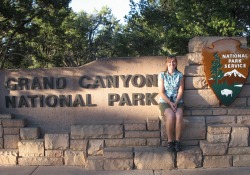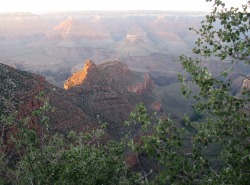|
Slept in, read a short story from Annie Proulx’s Close Range, and was then crestfallen upon discovering I only had two eggs left in the fridge—making Eggs Santa Fe requires five. Things improved when I reached Shoshone Point. There was one other car and the two occupants were walking out as I walked down the mile-long muddy dirt road. I have not seen true blue sky for about a week, but blue sky does not compare to the mysticism of a near white out. I’ve seen the canyon, or rather not seen it but felt its yawning presence in the black of star-gazing. Cloaked in night, the canyon gains additional power in what is obscured from view, but on a clear night that power felt benevolent. What I felt today was…two parts malevolent, one part awe. Half the attraction of Shoshone is that it is an unmarked viewpoint with a small dirt parking area and a sign presiding over the entrance of a gated roadway that advises use by permit only. The picnic area may be reserved by private parties, is rumored to be popular for weddings, and I believe it was a locale President Obama and his family visited the summer of 2009 (it’s a spot easily secured by men in black).
Trivia aside, it is not the common tourist that will note the spot in a guidebook, locate the turnoff, then trek the (gasp) one mile to the jutting cliff peninsula. The second part of the attraction is that there are no retaining walls, no fences, just you and empty space. Anyway, I was alone at midday in a boiling fog walking out along a well-worn path to the tipping point. A large stone the shape of a mushroom cap, presided over the view. But there was no view, or with some patience the fog would occasionally part to reveal distant buttes and pinnacles, flanked by white ghosts, mummified cotton, death shrouds. As I sat on a slab of cold stone the clouds enveloped me to such a state that I felt mildly claustrophobic. The air was heavy, thick. Willa Cather writes in Death Comes for the Archbishop, “Everywhere the sky is the roof of the world; but here the earth was the floor of the sky. The landscape one longed for when one was far away, the thing all about one, the world one actually lived in, was the sky, the sky!” On top of this suffocating white presence there were ominous rumblings to the north, directly across the canyon. This was thunder that mumbled rather than boomed. This dark gossip, coupled with the sky filling up my throat riveted me to the spot, as if to move would tear a hole in the atmosphere. Other than the northern vibration, there was no sound, like being suspended inside a box filled with liquid styrofoam on a cosmic mail truck. The penetration of the light brought amoebas out to play on the lenses of my eye. Maybe it was due to the slight distortion of vision that a contact lens wearer will never escape from, but they were there nonetheless, swimming under the titan currents of molecule and atom. After an adequate period of white hypnosis I left. To my knowledge the movement did not cause damage to the ozone. My next stop was the Tusayan museum and ruins. Getting there involved more exposure to white—the white of my knuckles as I braked for parts of the road lost beyond 10 feet ahead. Appropriately there were some orange construction signs left out that read “Use Caution. Smoke/Fog Ahead.” These were meant for a controlled burn of steepled undergrowth, stacked and cut. Every third oncoming car had their hazard lights on. The ruins were a series of shin high rock walls, ancient foundations of storerooms, living quarters, and a ceremonial kiva. The museum had atlatl, awl, mano and matate. A coyote pelt, velour shirt worn by the Navajo, a bored NPS employee smiling through his teeth at the wet tourists. Wait, velour? I had no idea that velour was a fabric used by tribes of the Southwest. It was introduced by the Spaniards sometimes in the 1500s. After the museum I decided to check out the Cameron Trading Post since I was already halfway there. I went to the Gallery first where a Navajo man was enlightening a couple about assimilation and cultural loss. A marvelous collection of rugs, jewelry, pottery, and a smattering of vintage buckskin clothes and bags. I don’t recall seeing anything under $1,000. True works of art. The majority of the parking lot was milling about in the ginormous souvenir shop adjacent to gallery, post office, gas station, and hotel. The merchandise was just about the polar opposite of the gallery contents. Cheap trinkets, mass production, shot glasses, tacky wallets, hideous “pottery” with unnatural colors and cliché patterns. It was sacrilegious really after having just seen black on black fired clay, shining with the care of one-of-a-kind craftsmanship. I purchased what I always do—paper and food stuff: postcards, a calendar for a family member, red chile jelly for a friend. I did look longingly at the turquoise inlaid silverwork beneath glass. Dead pawn is affordable, but I have yet to see a pawned Navajo rug—a genuine one appreciates in value. There was a huge rug-in-the-making on a loom, but the artisan was not at work while I was there. Curiosity satisfied I returned to Highway 64. I made a stop at the Little Colorado Scenic Overlook on the return trip. About five of the 30 makeshift wooden vendor shelters were occupied. No sign welcomes you to Navajo Nation, you simply know by the presence of these faded corrugated structures lining the roadside. Scenic overlook and artisan booths are synonymous on the reservation. When headed toward Cameron I had caught a brief glimpse of rust-colored water tumbling over a precipice along the gorge in a long ribbon. The rain had subsided upon return however, but orange puddles sitting in a wash gave evidence of recent torrents. Three dogs sat forlorn in the parking area. My week-long roommate and I had almost rear-ended a mini van that had braked suddenly for a pair of Rez dogs abruptly crossing the road on a return trip from Flagstaff. Ranger Lori, wrote a children’s book, The Adventures of Salt and Soap at Grand Canyon, about the discovery of two Rez puppies discovered at the bottom of the canyon. Lori eventually adopted them. I met Salt and Soap, now full grown, at a Fourth of July barbeque last month. Tribal custom is that animals are free agents, like the land, beholden to no one. Ownership and domestication is regulated to herds of sheep, cattle, and horses, wherein lies economic benefit. To date I have heard of no monetary undertaking produced by packs of dogs—at least in the southwest. The Innuit may feel differently. For a person indoctrinated into the opposite custom, the cultivation of animals as pets, I cannot help but see sadness in their canine eyes. Whether this is my own ethnocentric lens or real anguish on the part of the dogs I cannot say. I stopped at Grandview Point upon re-entering the Park. Too many people, too windy. Shoshone drew me back again, my intention to observe another canyon sunset. Again, only one car besides my own. A French couple, perched on the very edge of the point, now cleared of white, arms entwined peering over a map. At least two other parties came after me, but they retreated quickly. Whether it was the obvious privacy that the French lovebirds sought, or my solemn gaze to the West silently declaring all within sight my sanctuary. I actually brought out my binoculars for the first time on the trip in the desperate hopes of spotting a cougar or bighorn. No such luck, although I did see what may have been a backcountry composting toilet. It was apparent the sun was not going to break through for a final goodbye to the first of August so I left the embracing couple to their Fate. My impatience prevented me from being apart from vehicle however as the sky lit up lavender and coral just as I hit the turnoff to the village. I should have used the elk jam as an opportunity to document the blazing colors with photographic evidence…but I didn’t. It is not possible, nor moral, to capture every passing of the sun. Nor is it right to use flash on a calf nursing mother elk at dusk, put the lenses away people! Live in the moment. Although I have to wonder why the elk insist upon hanging out along the road. I may have misstated the elk story at the canyon in an earlier post. There were Roosevelt elk endemic to the area, but they dwindled to a few bleached bones. The elk you currently see roaming the lawn of El Tovar are imported from the Rocky Mountains. My evening ended with the eating of a hard little nectarine imported from California. The land of milk and honey has curdled…or what we should be doing is cultivating orchards…and elk in our backyards.
2 Comments
Leslie Sharp
8/4/2010 04:53:35 am
Jenny Gapp occupies a unique environmental and vocational niche that our species will need to survive the dark times to come. Keepers of the flame, people like Jenny are master orienteers, able to navigate their human adventure by reading the messages of Nature and then charting a brave route through the world using the gift of symbolic thought. This lady obviously rocks.
Reply
Steve Gapp
8/6/2010 12:34:56 pm
I sit on my back deck and read Jenny's thoughts on my laptop screen. The wind blowing in the cottonwood trees nearby sounds like the surf pounding the beaches at the Oregon coast. Everything here is green from a long, wet spring and an unusually cool summer. A bird sings in a blackberry thicket. A cool 70 degree breeze whispers of an early Fall to come. Although I have embraced technology I still marvel how I can read comments posted by my daughter, or anyone who choses to post a blog, anywhere on the planet, moments after their key strokes. I can hear the rumble of the thunder and sense the presence of the great chasm that she has embraced for these weeks. Your wit, keen powers of observation and obvious gift with words place me along side you. Remember that people all over the world may be doing the same. We are lucky to have you and hope you will be sharing similar experiences in the wild places of our great country for many years to come.
Reply
Your comment will be posted after it is approved.
Leave a Reply. |
AuthorJenny Gapp, has twenty years experience as a teacher librarian, four seasons as a seasonal state park ranger assistant, and two summers adventuring with National Parks in an official capacity. Archives
February 2024
Categories
All
|
 RSS Feed
RSS Feed



